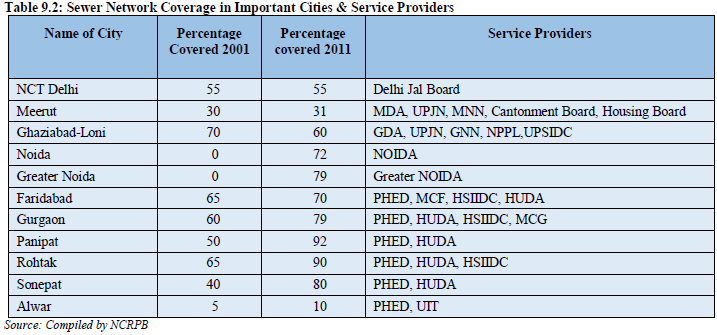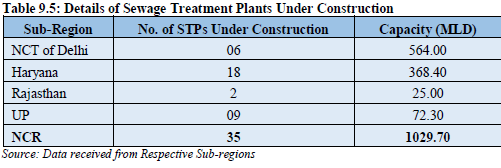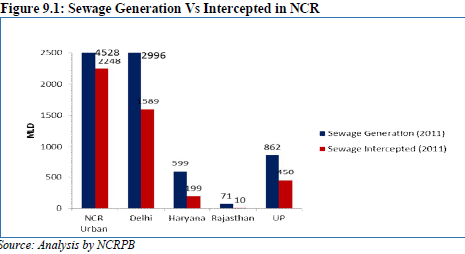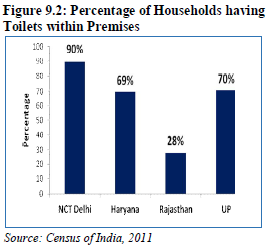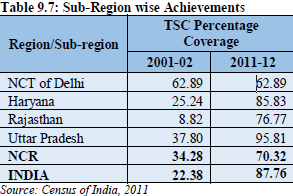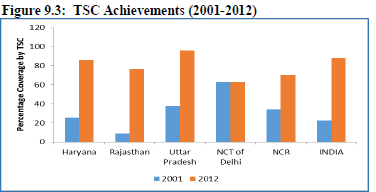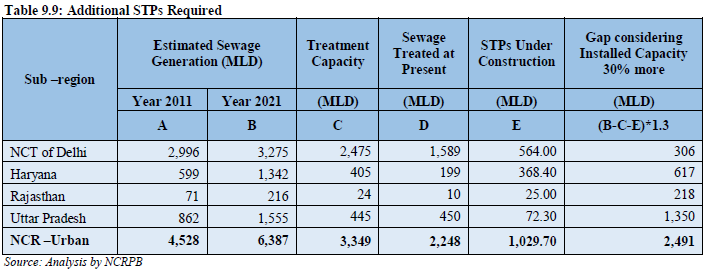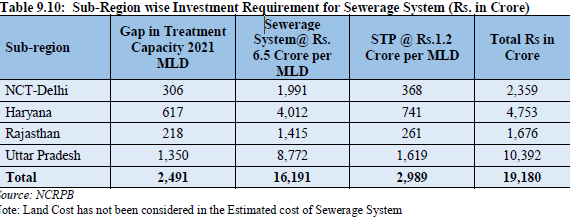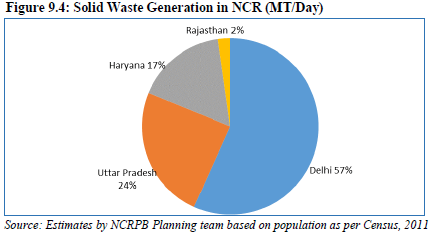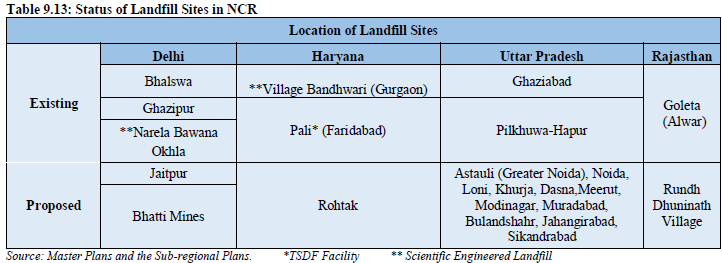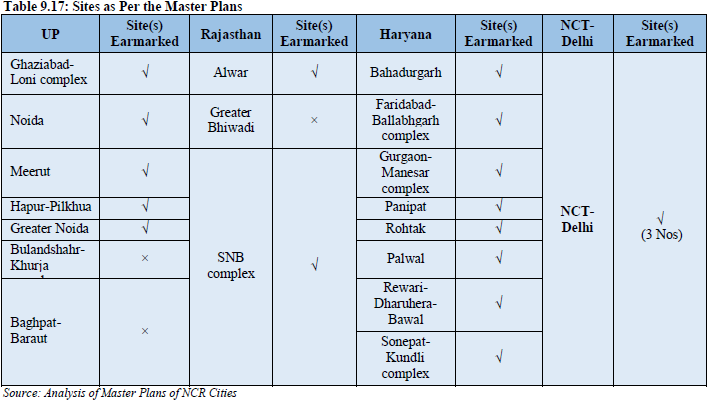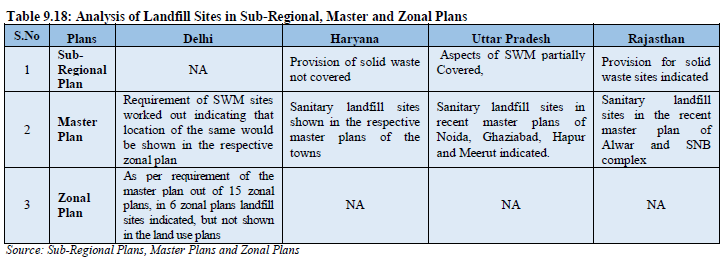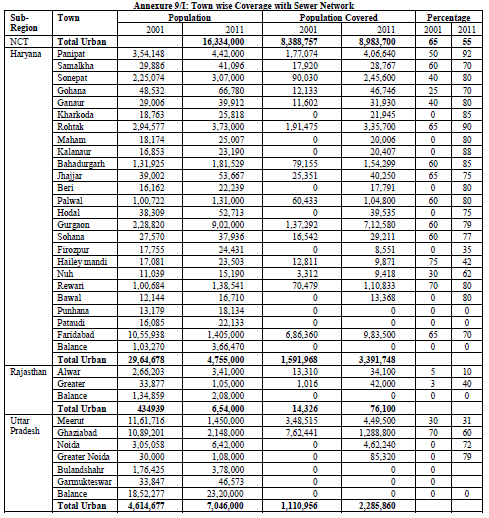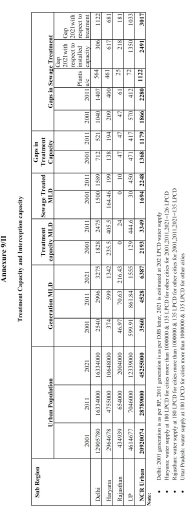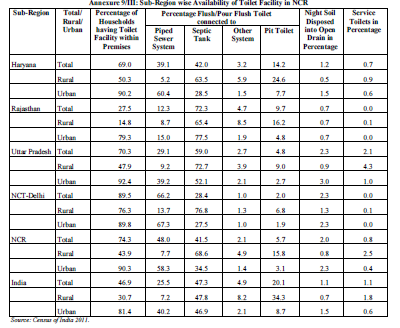Delhi: waste management
This article has been sourced from an authoritative, official readers who wish to update or add further details can do so on a ‘Part II’ of this article. |
Contents |
The source of this article
Draft Revised Regional Plan 2021: National Capital Region
July, 2013
National Capital Region Planning Board, Ministry of Urban Development, Govt. of India, Core-4B, First Floor, India Habitat Centre, Lodhi Road, New Delhi-110003
National Capital Region Planning Board
National Capital Region (India): Sewerage, Solid Waste Management, Drainage and Irrigation
SEWERAGE
9.1.1 Background
Sewerage is a core element of the physical infrastructure that determines the environmental status of any settlement. Planning and development of appropriate sewage carriage system with efficient treatment and cost recovery is the key component of urban physical infrastructure. Rehabilitation of old sewers, augmentation of existing sewerage system and sewage treatment capacities, extending sewerage system to uncovered areas, adoption of new technologies of waste treatment for higher degree of treatment to facilitate reuse and developing feasible and cost effective treatment for small and marginal settlements and rural areas is a huge task.
Low coverage of towns with sewerage system coupled with large and increasing gap in treated sewage and sewage generation also leads to degradation of the environment. The rivers (mainly Yamuna, Hindon and Kali Nadi) and various seasonal streams and drains in the NCR are under severe water quality threat due to untreated sewage polluting downstream areas. The surface water bodies and rivers receiving untreated wastewater are becoming unfit for bathing & unsuitable for drinking water.
The crisis in sewerage and sanitation has clear links to the imbalanced urban development and poor provision of wastewater infrastructure. Also, increased disease incidence, health risks and associated economic burdens have disproportionate impacts on the poor and vulnerable. This situation is aggravated by the on-going densification in the CNCR, the impact of climate change and the increasing groundwater pollution due to sewage infiltration. To address the problem of lack of sewerage system, a number of actions are immediately needed, such as (i) substantial investment in the construction of sewer network, conveying system and STPs, (ii) reuse of effluent (iii) energy generation in STPs and (iv) Institutional and financial management reforms to ensure that growth is environmentally sustainable and inclusive.
9.1.2 Existing Situation
A) Coverage of Sewage Network Services In NCR out of 108 towns only 33 towns have sewerage system and even in these 33 towns, the coverage can at best be classified as partial. In Uttar Pradesh sub-region only 6 towns are partially covered out of 63 towns, in Haryana sub-region 24 towns are partially covered out of 35 towns, in Rajasthan sub-region 2 towns are partially covered out of 9 towns. The population covered with sewer network is only 51% which is 2% less than the percentage of population covered in year 2001. NCR lags behind the MoUD bench mark of 100% coverage but it is far better than national average of 12.2% in terms of sewer network services. In absolute terms urban population in NCR during the decade 2001-11 has increased by 78.69 Lakh (37.6%) whereas the population covered with sewer network service has increased by 36.31 Lakh (33%). Thus the pace of sewer coverage is lagging far behind the increasing population. The city wise coverage is given in Annexure 9/I. The Sub-region wise coverage is given in Table 9.1.
The network coverage in some of the important cities in NCR and service providers are given in Table 9.2. The problem of low coverage and lack of sewerage system gets compounded by the multiplicity of authorities/utility/service providers even within the same city.
The network coverage in some of the important cities in NCR and service providers are given in Table 9.2. The problem of low coverage and lack of sewerage system gets compounded by the multiplicity of authorities/utility/service providers even within the same city.
C) Sewage Treatment Capacity
At present the sewage generation in NCR urban is 4,528 MLD. NCR has 64 STP’s of 3,349 MLD design capacity and the sewage treated is 2,248 MLD. Therefore, the sewage treated is 50% of sewage generation. The increase in sewage treatment capacity during the decade 2001-11 has been 53% whereas the increase in treated sewage quantity has been much less at 33%. The gap in the sewage generation over the sewage treatment is as high as 2,280 MLD. Sub-Region wise existing details of STPs, treatment capacity and treated quantity are given in Table 9.4.
Table 9.4 shows that in Delhi the quantity of sewage treated is 53% of sewage generated, in Haryana subregion
it is 33%, in Rajasthan sub-region it is 14% and in UP sub-region it is 52%. Also, thirty five
sewage treatment plants of capacity 1,030 MLD are under construction in NCR, Table 9.5.
The utilization of the installed capacity of STPs in Delhi is 64%, in Haryana Sub Region it is 49%, in Rajasthan Sub Region it is 41%, in UP sub region it is 101%. The overall utilization figure for NCR is 67%. Figure 9.1 shows the comparison of Sewage Generation and Intercepted in NCR.
In NCR urban areas, as much as 50% of the sewage generated is not intercepted, implying that 2280 MLD goes untreated into Water bodies/Drains/Rivers.
D) Reuse and Recycle
In NCT Delhi, 645 MLD of treated effluent is reported to be used in Horticulture/Irrigation/Power plant, against present sewage generation of 2996 MLD which works out to be 21%. In Haryana, 20-30% of the treated sewage of the STPs in Gurgaon is utilized for irrigation and the balance is discharged into Najafgarh drain which ultimately meets river Yamuna. 25-30 % of the treated sewage of the STPs in Faridabad is utilized for irrigation and the balance is discharged into Buria nala, Agra canal and Gaunchi drain. For the STPs in Panipat, 30-40% is utilized and the balance is discharged into Nohra drain and Panipat drain which ultimately meets river Yamuna.
E) Treated Sewage Quality
DJB/DPCC monitors the effluent quality of all STPs and in most of the cases the quality is within the acceptable standards. Data on quality of treated sewage of STPs in other sub regions is not available.
F) Preparation of Sewerage Master Plans
Regional Plan 2021 recommended preparation of Master Plans for Sewerage system in all the towns of NCR in order to have integrated Sewerage schemes and to avoid piece meal approach which ultimately increases number of intermediate sewage pumping stations. Out of 108 towns in NCR, only 32 towns have sewerage master plan. In Haryana sub-region, 27 towns have Sewerage Master Plans out of 35 towns. In UP sub-region, only 4 towns have Sewerage Master Plans out of 63 towns. In Rajasthan subregion, no Sewerage Master Plan has been prepared. Table 9.6 gives the details of sub region wise towns for which Sewerage Master Plans have been prepared.
G) Toilet Facilities
According to Census of India 2011 data, 74.3% of the total households in NCR have toilet facilities within the premises in comparison to all India average of 46.9%. In Haryana sub-region, it is 69.0%; in Rajasthan sub-region, it is 27.5%; in Uttar Pradesh sub-region, it is 70.3% and in NCT Delhi, it is 89.5%.
If we consider only urban areas in the NCR, the coverage of toilet facility within the premises is 90.3% in comparison to national coverage of 81.4%. In terms of coverage in rural areas, it is 43.9% against national coverage of 30.7%. In rural areas the sewage is carried through open kuccha drains and disposed off in fields and nearby ponds. Sub-Region wise details of availability of toilet facilities in urban and rural areas are given in Annexure 9/III. Figure 9.2 shows the percentage of households having toilets within premises.
The coverage of toilets in metro centres in NCR is 94% in Gurgaon, 91% in Faridabad, 95% in Sonepat Kundli, 97% in Ghaziabad Loni, 97% in Meerut, 96% in NOIDA and Greater NOIDA against MOUD bench mark of 100%. The national average in terms of coverage of toilets is 69.5%.
9.1.3 Government of India Schemes A) Flagship Schemes of Govt. of India Total Sanitation Campaign
Total Sanitation Campaign (TSC) is a flagship scheme of Government of India with an aim to ensure sanitation facilities in rural areas, to eradicate the practice of open defecation by 2017. Communities are facilitated to conduct their own appraisal and analysis of open defecation (OD) and take their own action to become ODF (open defecation free). CLTS (Community-Led Total Sanitation) focuses on the behavioural change needed to ensure real and sustainable improvements.
As per the information provided by Ministry of Drinking Water and Sanitation, the coverage of rural households for providing Toilet facility through Total Sanitation Campaign in India increased from 22.38 % in 2001 to 87.76 % in 2011-12. It increased from 34.28% (2001-02) to 70.32% (2011-12) in NCR. In Haryana sub-region, it increased from 25.24% (2001-02) to 85.83% (2011-12); in Rajasthan sub-region, it increased from 8.82% (2001-02) to 76.77% (2011-12); in UP sub-region, it increased from 37.80% (2001-02) to 95.81% (2011-12). Table 9.7 provides Sub-Region wise details of achievements of TSC in NCR and Figure 9.3 provides graphical comparison.
B) Project Financing by NCR Planning Board
NCRPB has financed 277 projects of which 38 projects are in the Sewerage, Sanitation and Drainage sector at an estimated cost of Rs 756 Crore for which a loan amount of Rs.453 Crore has been sanctioned. Out of these 38 projects, 20 projects are ongoing and 18 projects have been completed. Sub-region wise details are given in Table 9.8.
NCRPB assisted completed projects from sewer sector have already augmented the sewage treated
capacity by more than 36 MLD and sewerage network by 261 km in various small and medium towns. In
addition, the ongoing projects are proposed to augment the treatment capacity by another 171 MLD and
the sewerage network by 468 km in various towns of NCR.
9.1.4 Issues
Analysis of information provided by the NCR participating States as given in Tables 9.1 to 9.3 and Annexure 9/I and 9/II indicates that there is a substantial gap between demand and availability of sewer network and sewage treatment facility in NCR. The issues related to the sewerage system in NCR are given below:
A) Sewage Network Services
In NCR 75 cities out of 108 total numbers of cities are not covered with sewerage system. The remaining 33 cities also have partial sewerage system. The expansion of sewerage network has lagged behind the growth of population resulting in overflow of sewage into drains causing river pollution or creation of cess pools in low lying areas of the towns/settlements. The goal of coverage with 100% Sewerage system of all towns is reiterated not only in the revised Regional Plan 2021, but also in service level delivery benchmark of Ministry of Urban Development.
B) Sewage Treatment Capacity
The sewage treatment at present is 2,248 MLD against generation of 4,528 MLD. The sewage generation in the year 2021 will be 6,387 MLD. Thirty five number of sewage treatment plants of capacity 1,030 MLD are under various stages of construction. After taking into account construction of all the on-going STPs, the gap in quantity of sewage treatment and generation will continue to remain 1,250 MLD (4528- 2248-1030=1,250 MLD) at present and the gap will further increase to 3,109 MLD in the year 2021.
Moreover the planned capacity (Design capacity) of the STPs will be more than the required capacities as the plants are designed for design period of 10-30 years. Considering average design period of 10 years the installed capacity requirement shall be about 30% more than today’s requirement. The planning and implementation of STPs takes at least 5-6 years. It is also assumed that existing capacities of STPs will be utilised to full extent. Based on above assumptions NCR needs to plan and start implementation of STPs of capacity 2,491 MLD immediately. The requirement for UP sub region is of 1,350 MLD capacity, Haryana sub region needs addition of 617 MLD; Rajasthan sub region needs additional requirement of 218 MLD. NCT Delhi needs to use existing capacities of STPs and addition of 306 MLD new STPs apart from on-going work to reach a capacity of 564 MLD. The sub region wise details are given in Table 9.9.
C) Reuse and Recycle
Recycling/Reuse of treated sewage is insufficient at present as reuse system/network are not developed. Planning for prospective users is not done at the time of conceiving STPs. Sewage generation in NCR is estimated to be 6,387 MLD by the year 2021. Assuming that 80% of generated sewage after treatment will be available for recycling or reuse, 5,101 MLD treated sewage effluent will be available for reuse in NCR by 2021. The treated sewage available for reuse shall be 2,620
MLD in Delhi, 1,074 MLD in Haryana sub region, 1,244 MLD in UP sub region and 173 MLD in
Rajasthan sub region.
D) Operation and Maintenance
The lack of proper maintenance of the sewerage system results in blockage and overflowing of sewers, opens manholes and back-flows. Throwing street sweepings and garbage into manholes/open drains results in blocking of sewers and creates cess pools resulting in environmental degradation and diseases. Age old system of manual cleaning of sewers is still followed instead of use of modern machines like jetting cum suction machines, which are quick and do not damage the inner surface of the sewers. The upper reaches of sewerage system, where flow mostly remains below the self-cleansing velocity, are silted up as they have no system of regular flushing. There is need for a comprehensive maintenance plan for de-silting of the entire sewer system of a city.
The operation and maintenance of STPs has been neglected. Often sewage is bypassed from STPs. At many places the condition of mechanical and electrical equipment is poor and pumps are old which consume more power. Renewals are not done timely. Preventive maintenance is generally not done. Cost recovery and collection efficiencies are poor. Revenue generation through recovery of resources viz.
recycled water, manure and waste to energy plans; should be added for recovery of the expenditure in operation & maintenance. Proper and adequate maintenance is not possible in case of less cost recovery.
E) Imbalances in the Coverage
There are imbalances in the coverage of municipal sewerage system in various parts of the cities. Significant portion of the city population particularly living in marginal settlements, unauthorized colonies and urban villages do not have sewerage system.
F) Rehabilitation & Phasing out Existing Sewer Network & STPs
In older parts of cities the sewerage system is old, silted and overloaded, requiring phased replacement or rehabilitation. Development authorities associated with development of new areas in various towns/cities take care of sewerage system in newly developed sectors only. Provision of sewerage system and treatment facilities in the existing areas is considered as the sole responsibility of the local bodies which have neither sufficient financial resources nor appropriate technical staff to provide such facilities. ULBs are generally dependent upon the State Governments.
G) Sewerage Facilities in Rural Areas
Analysis of Census 2011 data (Table 9.7) indicates that the coverage of households in rural areas in NCR with the toilet facilities within premises is 44%. About 15.8% of the households are having toilets in the form of Pit Toilets which directly pollute the ground water and about 3.3% households have toilets in the form of either service toilets or directly dispose of night soil into the open drains. In Haryana Sub-Region, percentage of households with pit toilets is highest i.e 24.6 % and in UP Sub-Region, the percentage of households having Toilets in the form of either service Toilets or directly dispose of night soil into the open drains is highest i.e. 4.3%. Sub-region wise details are given in Table 9.7.
H) Treatment of Industrial & Hotel Waste
Industrial wastes are sometimes not treated and are disposed in public sewers or in streams/drains. This waste is highly concentrated and needs separate and special treatment before disposal in public sewer or in drains. The legislations to prevent this are in place but administration and monitoring mechanisms are weak and ineffective. Industrial areas should have common effluent treatment plants. Also, restaurants should discharge their waste water after primary treatment through grease interceptors and larger hotels should have independent sewage treatment facility.
I) Land Availability for STPs The land for construction of new STPs is a major constraint in all sub-regions and therefore it is imperative to earmark land for STPs in the Master Plans.
J) Availability of Data Data pertaining to network service area, inflow in STPs, treated quantity, influent and effluent characteristics of sewage reuse quantity, expenditures, revenues, cost recovery, collection efficiency, sewer connections etc. are generally not available. It is difficult to evaluate performance of STPs and sewage service and understand gaps. This data is necessary for future planning of sewerage facilities.
9.1.5 Policies and Proposals In order to improve the sewerage system in the NCR for the harmonized and balanced development by the perspective year 2021, following policies and strategies are proposed:
A) Preparation of Master Plan for Sewerage System Each participating State with the help of the specialized agencies and experts should prepare detailed and integrated Sewerage Master Plans for each city integrated with Land Use Plan of the city. The Master Plan be for atleast 20 year horizon period and must cover the extended boundary of the city as per proposed land use.
Plan should address area for onsite sanitation and area for offsite sanitation (sewerage system). It should identify land required for STPs and their locations. The plan should provide rehabilitation of the existing network, STPs and Sewage Pumping Stations; extension of the sewer network, increase in treatment capacity, effluent requirements, disposal system, recycling the treated effluent for irrigation, ‘peri-urban agriculture’, urban agriculture, gardening, flushing of sewers and cooling in industries/hotels etc. Individual and/or common effluent treatment plants in industrial estates, grey water treatment and its recycling in residential apartments, hospitals, schools, hotels, etc. be promoted. The plan should prioritize works and propose phased investments. Associated environmental, social, financial, institutional & technical issues should be addressed.
B) Allocation of Land for Sewerage Schemes Master/Development Plans of the towns and cities should notify and incorporate land allocations at appropriate locations for following components of the sewerage schemes:
i. Adequate corridor should be provided for laying of sewerage network and treated waste water recycling pipe lines along roads as per standard cross sections.
ii. Depending upon quantity of sewage to be pumped, land area for sewage pumping stations needs to be allocated (on an average, area of 0.25 hectare should be reserved for each pumping station). iii. Adequate land area (0.2-1.0 hectare/MLD) should be reserved for sewage treatment plant as per the technology adopted.
C) Service Level Bench Marking It is suggested that in order to focus on service delivery in the 7 metro centres, NCRPB may get a study conducted on the present status and improvements that could be carried out in respect of sewage service level benchmarks developed by MoUD.
D) Network Coverage
All towns should be covered such that 100% population is served by sewerage system or by on site sanitation. The implementation of sewerage system in towns should be prioritized based on higher population, less per capita investment, financial sustainability, reuse potential and O&M capacity. Piecemeal approach for laying of sewers should be avoided.
E) Sewage Treatment Capacity & Effluent Quality
STPs should be constructed of modular design so that the large capacities do not remain unutilized. Sewage should be treated as per standards laid down by MoEF/CPCB under the Environmental Protection Act, 1986 before it is discharged on land for irrigation, plantation, gardening etc. or into the water bodies. The grey water treatment and its recycling in residential apartments, hospitals, schools, hotels etc should also be encouraged. Sewage treatment facilities should be provided simultaneously in a phased manner
while developing the new areas in a town. No untreated sewage should be allowed to flow into water bodies/drains/rivers.
E) Decentralized Wastewater Treatment In case of centralized wastewater treatment plant the network sizes are larger and pumping costs are more as compared to centralized wastewater treatment plants. Also long pipelines are required to be laid for reuse of treated effluent in case of centralized wastewater treatment as the users are situated upstream of the WWTP. The pumping costs for reuse increases due to higher head pumping. Therefore the decentralized wastewater management systems should be encouraged.
F) Recycling of Waste Water for Non Drinking Water Use Recycled waste water should be promoted for non-drinking purposes and necessary infrastructure should be developed to facilitate reuse and recycling of treated waste water. The reuse of water recovered from grey waste water treatment at low cost needs to be promoted in multi storied apartments, schools, Hotels, industrial units and large installations. Fiscal measures such as quantum based taxation for waste water for institutions and commercial establishments be taken up which will not only reduce the cost of treatment for the municipalities but will ultimately help in improving the overall environment of the cities.
About 5101 MLD of treated waste water will be available for recycling and reuse. All new development areas may have two distribution lines, one for drinking water and other for non-drinking water/recycled treated waste water for reuse. Water requirements for non-drinking purpose in big hotels, industrial units, central air-conditioning of large buildings/institutions, large installations, irrigation of parks/green areas and other non-potable/ non- human contact demands should be met with through treated recycled waste water. Proper and adequate infrastructure should be planned and implemented for the reuse of treated sewage. Individual grey water treatment and recycling units should be promoted in small communities, schools and Institutions.
Almost 80% of the treated waste water can be recycled on whole. State Government may consider providing liberal tax rebates for institutions/industries adopting recycled waste water to compensate for the cost involved in treating waste water for recycling. If required, enabling provisions in the respective Acts of the local bodies may be made by the respective State Governments.
G) Rehabilitation/Augmentation of Sewerage System and Treatment Facilities Poor condition of existing sewerage system in townships/cities should be rehabilitated and wherever, sewerage facility in part of town is not available or is not up to the desired level, augmentation schemes, should be taken up. Since treatment facilities in most of the townships are less, emphasis should also be given to provide the same, as per the requirement.
H) Adoption of Energy Efficient Treatment Processes and Energy Generation from Sludge The wastewater treatment plants with energy efficient mechanized treatment processes including energy generation from sludge digestion or gasification be encouraged. To mitigate the problem of intermittent and unreliable power supply, dedicated power supply from the national grid and standby diesel generator sets to ensure continuous power supply for the STPs be taken up. The STPs will also include proper measures for automation with supervisory control and data acquisition (SCADA) systems.
I) O&M Embedded Construction Contracts for Operational Sustainability To mitigate O&M capacity of ULBs and ensure operational sustainability, O&M embedded construction contracts combining design, construction and O&M for wastewater treatment plants shall be taken up. This will encourage the contractors to improve quality of construction and provide continuity in system operation.
J) Operation and Maintenance Operation and maintenance of sewerage system should be done in a planned manner and should be given priority by the local bodies. The maintenance of sewerage system should be carried out by using modern
technology/equipment. Technical and financial resources of local bodies for proper O&M of sewerage system and STP’s should be considered for enhancing their capacity. Technical resources may be outsourced as required.
The O&M of the existing sewage treatment facilities should be done through expert and experienced reputed agencies on long term agreement (5-10 years), preferably on Public-Private-Partnership (PPP) model, and resource recovery and promotion of use of recycled water should be included in the agreement.
K) On site Sanitation The towns within NCR, which do not have sufficient resources or have unsuitable terrain to provide proper sewerage system and treatment facilities, may initially be provided with low cost sanitation system which can be upgraded at later stages within the time frame of master plan. Densely populated parts of towns can be provided with sewerage system and thinly populated parts can be provided with onsite sanitation system. Pit Toilets which directly pollute the ground water, service Toilets and direct disposal of night soil into the open drains should be discouraged and the target should be to reduce this component from 15.8% in 2011 to 0% in 2021.
L) Septage Management The evacuation of sludge from septic tanks should be institutionalised and its proper disposal should be planned.
M) Sewerage System in Villages
Urban villages should be provided with the facilities equivalent to the towns, within their controlled areas. Large villages may be provided with low cost sewage treatment facilities with appropriate sewerage system. Other rural areas should be provided with low cost sanitation measures such as sanitary toilets and septic tanks. The target should be that all the villages in NCR are provided with appropriate wastewater management system by 2021. Moreover the water supply should be strengthened to support sewerage system.
N) Institutional Reforms
Policy of having dual agencies for construction and operation & maintenance of these facilities in some of the constituent States should be discouraged. To have better environmental management and to avoid over-loading/under-loading of the system and for focused accountability, overall management of sewerage system and surface drains with its effluent treatment facilities should be entrusted to a single agency in a given town.
O) Creation of Mass Awareness
It is imperative to create mass awareness among public through mass media with regard to saving of water, waste minimization and utilization of treated waste water for non-drinking purposes. ‘Public Participation and Awareness’ programme should be made a mandatory component of each sewerage project and suitable provision of cost for the necessary activities may be made in the DPR.
P) Commercial Approach for Tariff With the increased requirement of improved quality of life, Government should not be dependent upon to continue with the subsidies for improving the sewerage system in the times to come. Commercial approach should be adopted by the local bodies for revenue generation. Tariff should be fixed so as to meet at least the operation and maintenance cost of the sewerage system. Introduction of sewage tax and improved recovery of taxes may help in reducing the revenue-expenditure gap. Some state government departments/ULBs levy sewage charges as some % of water charges. Such system leave out the private/own water supply consumers although they may be disposing waste in public sewers. Such consumers should be surveyed and charged as per water used by them whether water is supplied by utility or not.
The structure of the sewage tax should be demand based and increased telescopically depending upon the monthly consumption of water and should be reviewed periodically as a built-in mechanism to make the service self-sustaining and a deterrent to wastage.
Q) Norms and Standards
Norms and standards provided in the CPHEEO Manual for sewerage and its treatment, ‘Guidelines for Preparation of Project Reports under National River Conservation Plan and National Ganga River Basin Authority’, Ministry of Environment and Forest (MoEF), CPCB Standards and relevant Bureau of Indian Standards should be followed while framing the DPRs for sewerage system, sewage treatment facility and recycling infrastructure. Efforts should be made to bring effluent of STP within stringent norms laid down by MoEF vide its order dated 03 February, 2010. The ‘National Urban Sanitation Policy’ of MoUD, Govt. of India should be followed while framing the Sewerage DPRs.
R) Institutional Capacity Building
Institutional capacity building measures for management of sewerage system and sewage treatment plants in the towns should be done for efficient operation and maintenance of the system. Simultaneously, it should contribute towards improvement in the self-sustainability of the system.
Funding and Plan of Action
A) Funding of Sewerage and Sewage Treatment Schemes Presently the utility and service infrastructure in the region is mainly funded by MoUD, MoEF, NCRPB and State Govt. with some share of local bodies. The share of State Government should be provided in the state plan for NCR Sub-region of the respective States, while the Central Government grant could be a part of the NCR Planning Board’s central budgetary provision. The loan component can be met by the NCR Planning Board through its Internal Extra Budgetary Resources (IEBR). Augmentation and upgradation of sewerage schemes/sewage treatment plants in older areas may be financed through this funding. External Development Charges (EDC) / Infrastructure Development Fund (IDF) collected by the development authorities from a town should be invested within the same town in proportion to the population of existing town proposed to be developed.
B) Plan of Action and Phasing of Implementation of Strategies/Policies/Proposals In order to implement the policies of sewerage system in the region it is imperative to have a plan of action along with phasing so that the implementation of policies and proposals in the Regional Plan can be dovetailed in the State plans.
Industries/hotels/large institutions should be asked to use at least 50% of their waste water in their institutions itself and no fresh water should be allowed to be used for urban agriculture/ agriculture/horticulture purpose in the inhabited areas to promote use of treated waste water. Amendment in Act/statute, if required, should be carried out for the reuse and recycle of wastewater. Improvement/augmentation in the existing sewerage system and construction of sewage treatment plants in the region, should be carried out in a phased manner.
C) Investment Plan Total estimated sewage generation in the urban areas of the region is estimated to be 6,387 MLD by the year 2021. Accordingly, there will be need to strengthen/expand the sewerage system and its treatment capacities. Total investment required for laying of sewerage system would be Rs.16,191 Crore by the year 2021 and for treatment of waste water, the investment would amount to Rs.2,989 Crore. It is based on the existing situation. Sub-region wise and Plan wise fund requirement for the NCR has been given in Table 9.10 & Table 9.11.
SOLID WASTE MANAGEMENT
9.2.1 Background Solid Waste Management (SWM) is increasingly becoming an important challenge in towns and cities. Over the years the amount of municipal solid waste generated in cities has been increasing due to rapid growth of urban population, improvements in economic conditions, change in lifestyles and consumption patterns. The amount of per capita generation of solid waste in India is estimated to have increased at a rate of 1% - 1.33 % annually1. Municipal solid waste is heterogeneous in nature and consists of a number of materials generated by various activities as indicated in Box 9.1.
Box 9.1 On the basis of source and degeneration characteristics solid waste can be classified as follows: 1. Municipal Solid Waste: As per the Municipal Solid Waste (Management & Handling) Rules 2000 garbage is defined as MSW which includes commercial and residential waste generated in a municipal or notified areas in either solid or semisolid form.
2. E- Waste: As per the CPCB Guidelines (2008), “e-waste is defined as waste generated from used electronic devices and household appliances which are not fit for their originally intended use and are destined for recovery, recycling and disposal.”
3. Hazardous Waste: Hazardous waste has been defined in Rule 3 of the Hazardous Wastes (Management, Handling and Trans-boundary Movement) Rules, 2008 came into force with effect from Sep. 24, 2008, as any waste, which by reason of any of its physical, chemical, reactive, toxic, flammable, explosive or corrosive characteristics causes danger or is likely to cause danger to health or environment, whether alone or when in contact with other wastes or substances.
4. Plastic Waste: “Plastics are non-biodegradable, synthetic polymers derived primarily from petro-fossil feedstock and made-up of long chain hydrocarbons with additives and can be moulded into finished products CPCB, 2012). In India, approximately 8 Million tonnes plastic products are consumed every year (2008).
5. Construction and Demolition Waste: Construction and Demolition waste is generated whenever any construction/demolition activity takes place. It consists mostly of inert and non-biodegradable material such as concrete, plaster, metal, wood, plastics etc.
6. Biomedical Waste: Bio-Medical Waste is generated during the diagnosis, treatment or immunisation of human beings or animals, or in research activities pertaining thereto, or in the production or testing of biological and including categories mentioned in Schedule-I of the Bio Medical Waste (Management and Handling) Rules 1998. 1 NEERI Report: Strategy paper on SWM in India, August 1995.
9.2.2 Existing Situation As per the NEERI study, solid waste generated in Indian cities has increased from 6 million tonnes in 1947 to 48 million tonnes in 1997 and is expected to increase to 130 million tonnes per annum by 20212 indicating that from 1947 to 1997, generation of solid waste increased by 8 times whereas urban population increased by 3 times.
As per NCRPB estimates based on population as per Census (2011), 13,199 MT solid waste is generated per day in NCR in the year 2011. Highest amount of solid waste was generated in Delhi i.e. 10,051 MT/day (76%) followed by UP sub-region 1,638 MT/day (12%), Haryana sub-region 1,373 MT/day (10%) and Rajasthan 137 MT/day (1.03%). The methodology for estimating the MSW is based on the per capita generation of MSW in accordance with the norms prescribed by CPHEEO norms (Table 9.12).
At present, there are inadequate numbers of landfill sites for disposal of solid waste generated in entire NCR. The available information on landfill sites in NCR is given in Table 9.13.
Most of the above existing landfill sites located in Delhi are brimming with solid waste and have already exhausted their lifespans.
9.2.3 Recycle and Reuse of Solid Waste
The Municipal Corporation/ Municipal Councils and other agencies responsible for managing the solid waste have made some efforts to recycle the waste and also to generate power from the waste. Sub-region wise picture is discussed below: A) NCT-Delhi Sub-Region: Three Waste to Energy plants have been planned for Delhi at Okhla, Ghazipur & Bawana. These three ‘Waste to Energy’ plants will reduce the problem of disposal of biodegradable municipal solid waste. Timarpur - Okhla ‘Waste to Energy’ plant is operational and other two are under installation. Details are as under in Table 9.14.
A Construction and Demolition waste plant of capacity 500 Metric Tonnes Per Day has been installed by M/s IL&FS and is operational at Jahangirpuri for processing of construction and demolition waste in Delhi. Processed C&D material is used for tiles/pavement blocks and also in ready mix concrete. Two new compost plants are planned for Delhi i.e. M/s IL&FS compost Plant at Okhla and M/s Delhi MSW Solutions Ltd., Narela Bawana Road of capacity 200 MTD & 1500 MTD respectively. APMC Tikri plant is not operational. Existing compost plant at Bhalswa is operational.
B) Rajasthan Sub-Region: In Rajasthan Sub-region, Awas Vikas Ltd has commissioned a landfill at Goleta and also planned a 25 MT/day compost plant, but yet to be executed. The present waste collected in Alwar city is being dumped in the landfill site at village Agyara. This 11 ha clay lined engineered landfill, situated on a site of 15 ha and is equipped with drains and ponds to collect and treat leachate. Another solid waste disposal site has also been planned at Rundh Dhuninath Village behind Ashok Leyland Ltd at MIA. Earlier, the proposal was to allot approx. 50 ha of land for this purpose. However, at present only 12.5 ha of land has been allotted for this purpose. This site will be used for solid waste disposal for Alwar city as well as bio-medical waste management, treatment and disposal. It is proposed to install a Waste to Energy plant at this site.
C) Uttar Pradesh Sub-Region: In Greater Noida, Greater Noida Authority has identified a land of 126 acre near village Astauli, 30 Km from Greater Noida. To reduce the expenditure on transferring of waste, Refuse Transfer station is proposed to be developed on 2 acre land. This Engineering Sanitary Landfill & Waste Processing Facility will have Material Recovery Facility (MRF) and Compost and Refuse Derived Fuel (RDF) facilities. This project will be operated on the basis of DBOOT (Design, Built, Own, Operate and Transfer) for minimum 25 years. Noida Authority has identified a new site for establishing Integrated Municipal Solid Waste Treatment and disposal Facility in Sector 123. D) Haryana Sub-Region: An integrated SWM project for Rohtak Municipal Corporation comprising 175 TPD MSW processing plant and a sanitary landfill is under implementation. Another project at Sonepat for 145 TPD MSW processing facility is under construction. In addition, a project to process 1000 TPD of MSW from Gurgoan and Faridabad cities was set up at Village Bandhwari on Gurgoan- Faridabad highway along with the sanitary landfill facility. MSW processing facilities for Panipat, Bahadurgarh, Hodel, Dharuhera, Ferozpur Jhirka and Farukhnagar are at various stages of planning/ implementation.
9.2.5 Provision of Landfill Sites in Master Plans: It is imperative that SWM sites are identified and
marked in the Master Plans which are statutory documents. An analysis of Master Plans in NCR sub
regions reveals the following:
A) Uttar Pradesh Sub-Region: Master plans of 4 towns namely Noida, Ghaziabad, Hapur and Meerut have earmarked sanitary landfill sites in the land use plans. However, in the Master Plans of Bulandshar and Khurja landfill sites are not located. Information on other towns in the sub-regions is not available.
B) Haryana Sub-Region: For Gurgoan and Faridabad, there is no separate landfill site and a common landfill site for both the towns is developed at Village Bandhwari. In the Master plans of Sonepat, Palwal, Panipat and Bahadurgarh suitable provision for sanitary landfill sites have been made and also indicated in the respective land use plans.
In Rohtak, an area of about 20 hectares has been proposed in the master plan and in Rewari a site measuring 10.61 acres has been earmarked for disposal of solid waste at Village Bhagwanpur which is in the vicinity of the town.
C) Rajasthan Sub-Region: As per the master plan of Alwar, a site has been developed at village Agyara by Awas Vikas Ltd.
D) NCT Delhi: Presently solid waste is being dumped at three landfill sites, namely Bhalswa, Ghazipur and Okhla and three new sites have been identified at Jaitpur, Narela Bawana Road and Bhatti mines. DDA has yet to handover the land for the new sites to the Municipal Corporation. In NCR, among the 18 metro & regional centres, 16 have earmarked sites for sanitary landfill in their respective master plans as shown in Table 9.17.
DRAINAGE
9.3.1 Background Drainage is an important element of physical infrastructure and constitutes removal and disposal of surplus rain/irrigation water from the land. It has two aspects namely flood protection and removal of storm water. National Capital Region in general, is a part of well integrated drainage system of the Ganga basin. The extremely gentle gradient prevalent almost all over the region restricts the degradation activities of the streams/drains. The storm water discharge in any basin/sub-basin of NCR is not local but has regional bearing covering areas of Haryana, Rajasthan, Uttar Pradesh and NCT of Delhi.
It is, therefore, necessary to plan the drainage system at regional level in an integrated manner with adjoining States. Topography, rainfall intensity, soil characteristics, irrigation methods, crops and vegetation cover are important factors for deciding the type and design of drainage system. Since urban expansion is inevitable, increased run off would require remodeling of the existing drains as well as provisions of new/supplementary drains, implementation of appropriate flood protection measures, protection of natural drainage course, improved ground water recharge, and other environmental improvement measures such as prevention of sewer flows into the storm drains, pollution of river Yamuna etc. Provision of appropriate drainage in marginal settlements consisting of JJ clusters, resettlement colonies, informal/unauthorized colonies, etc, also requires due attention.
Regional Plan-2001 proposed that open drains, which are by and large the sources of nuisance and pollution, should be discouraged and discontinued. Major drains should be covered but are generally found open and road side smaller drains are also sometimes found open. Some of the towns have combined system of disposal for sewage and storm water. However generally it is not designed as such but by default in absence of sewerage system, the drains actually act as combined system both for sewage and drainage. The disposal of storm water is generally not planned properly and takes natural course on land, depressions, ponds etc. Separate systems for sewage and storm water disposal are recommended in NCR.
9.3.2 Existing Situation and Issues Studies have revealed that there is lack of integrated planning in the drainage for storm water which is not local but has got regional bearing covering areas in Haryana, Rajasthan, U.P. and NCT-Delhi Subregions. Untreated sewage continues to flow in most of the drains in the region and ultimately falls into the rivers Ganga and Yamuna. Encroachment by slums along the drains cause choking of drains and flooding in the upstream areas due to reduced carrying capacity. Dumping of solid waste in the drains also causes blockage. Drainage Master Plans have not been prepared district wise and city wise. Ideally, the hydraulic survey should be carried out regularly to assess the conditions of the drains.
IRRIGATION
9.4.1 Background Water requirement for irrigation is closely related to population, demand for food, production of non-food agricultural and industrial items, improvement in quality of life and preservation of ecology and environment.
9.4.2 Issues Studies have revealed that the requirement of water for irrigation in the region cannot be seen in isolation. The demand for drinking water and industrial use have also to be considered.
A) Insufficient Water Sources in the Region
The present surface water resources of the NCR are insufficient to meet the requirement of the various sectors. A holistic view of water requirements should be taken including the demand for the drinking water supply, industrial use and irrigation assigning priority to drinking water and industrial use. Drinking water requirement for the entire NCR in the year 2001 was 6,330 MLD (6.33 MCM/day or 2,310 MCM/annum) and the projections for the year 2021 are 8,620 MLD (8.6 MCM/day or 3,147 MCM/annum). The estimated annual water demand of NCR in the year 2021 for drinking water, industry and agriculture is projected to be 23,435 MCM as mentioned below:
Drinking Water 3,178 MCM/annum Industrial use 1,996 MCM/annum Irrigation 18,292 MCM/annum Total Demand 23,466 MCM/annum This water requirement cannot be met from river Yamuna alone. The average annual water availability of river Yamuna up to Delhi has been assessed at 12,000 MCM. The Ganga basin is also water deficit up to Allahabad. Present canal system of Yamuna, Ganga and Bhakra Beas meet the surface water demand of NCR and NCT-Delhi. The MOU signed on 12th May 1994 by the Chief Ministers of the Co-basin States provides annual allocation of 5,730 MCM to Haryana, 1,119 MCM to Rajasthan, 4,032 MCM to U.P., 378 MCM to Himachal Pradesh and 724 MCM to NCT-Delhi. The agreement takes care of the irrigation and consumptive drinking water needs of all Co-basin States. The MOU also provides for separate agreement to be executed in respect of each storage identified in the Upper Yamuna river basin within the overall allocation made under the agreement. A part of the demand is also met from ground water. However, entire NCR has been witnessing decline in ground water levels. A more detailed analysis of ground water availability and decline in water levels are given in Regional Plan chapter on Environment and Water.
B) Lack of Ground Water Recharging Resulting in the Depletion of Ground Water The rate of development of the groundwater resources is unsustainable with most districts of the NCR that are sliding into the dark zone category as discussed in previous paragraph. This is due to lack of ground water recharging, higher rate of withdrawal; fast pace of urbanization and reduction in run off time for rainwater. Thus, recharge of groundwater is a priority.
C) Sources Outside the Region Planning and development in NCR, for the existing situation, is based upon the assurance of water supply from the three proposed dams in the Himalayas, for augmenting surface flow. The infrastructure work on these dams is held up for want of clearances. Even if the construction is initiated immediately, these dams would not be ready for use for next 10-15 years, thus jeopardizing the NCR Plan.

